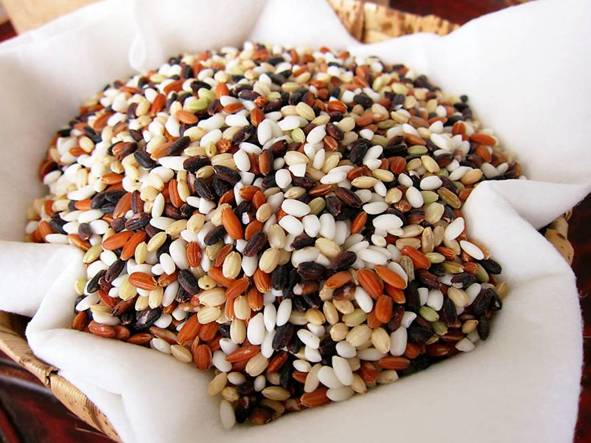Posted on Nov. 21, 2013 on The Japan Times
http://www.japantimes.co.jp/life/2013/11/21/food/demand-booming-for-artisanal-rice/
by Makiko Itoh

Grain of hope: A mix of organically grown ancient and white rices, which some farmers are using to boost trade. | MAKIKO ITOH
Rice farmers in Japan are under siege. Heavily protected on various levels by the central government for decades, they’ve seen the market for their precious crop eroded by cheaper imported rice, and the administration of Shinzo Abe is proposing ending production-rationing and subsidies. It will be interesting to see how the farmers will cope with this in upcoming years.
One way in which some farmers have already adapted is to concentrate on quality rice grown with care in small quantities, and sold at a premium price — or in other words, artisanal rice. Instead of growing high-yield rice hybrids as most large-scale farms do, these farms concentrate on varieties that taste good regardless of their yield. The rice is usually grown using low-chemical or organic methods, and genetically modified varieties are emphatically avoided. In addition, many of these farmers emphasize the purity of the water that is used to flood their rice fields. For example, Nonki Farm in Harie, Shiga Prefecture, proudly declares that its water source was designated as one of the top 100 natural springs in Japan.
Some artisanal-rice farmers are also trying out heirloom varieties of rice that had been abandoned in the postwar period. Called kodai-mai (ancient rice), these varieties come in intriguing natural colors such as green, red-purple and black. Most have a sticky glutinous quality like mochi or sweet rice.
Besides their color and flavor, these ancient rice varieties are said to have nutritional benefits too, or at least more so than plain old white rice. Aka-mai (red rice) is rich in tannins just like red wine, and ryoku-mai (green rice) has chlorophyll. Black rice, called kuro-mai, has the most purported health benefits: The rich purple-black color comes from anthocyanins, and the grain is also rich in vitamin C and various minerals.
All of these ancient grains are unhulled, so they have more fiber, too.
The only drawback to these grains may be cost — they are several times more expensive than even the premium artisanal white rice grown by the same farmers. So they are often mixed in small quantities into regular white rice. A small handful of black rice mixed into regular rice, for example, turns the white rice light purple, similar to the way adzuki beans turn rice red in osekihan.
Rice grown with great care like this should be treated with respect when cooking. You can use your rice cooker, a donabe (earthenware pot) or a regular pan, but do rinse the grains gently rather than scrubbing them hard (they usually have very little nuka [rice talc] on them) and soak them for at least half an hour before cooking, or an hour if using ancient grains. In addition, make sure to rest the rice for a while after cooking so that it can absorb any excess moisture.
The best place to try these varieties of rice is at regional food and product fairs held in department-store food halls as well as at some train stations, where you can sample the rice before you buy. You can also find sellers on the Rakuten online shopping mall too. You might even find some of them at your local rice seller or supermarket.
Original Article: The Japan Times
http://www.japantimes.co.jp/life/2013/11/21/food/demand-booming-for-artisanal-rice/
